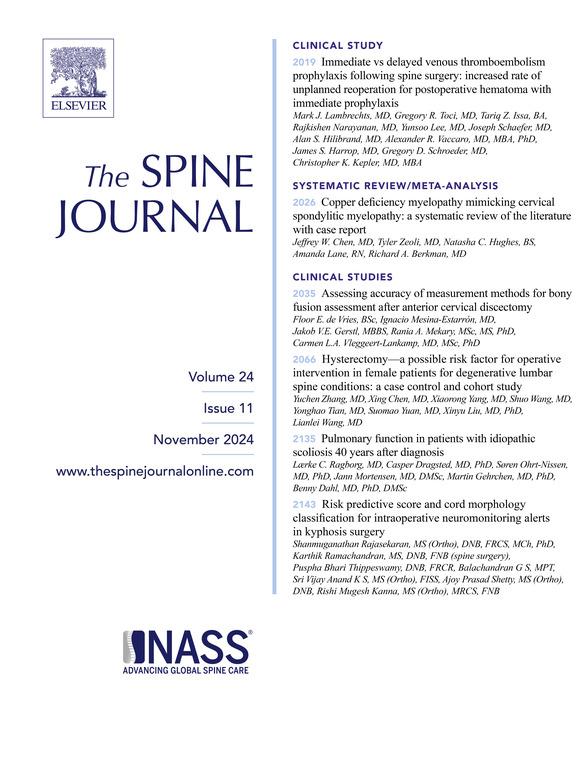49. The association between postoperative physical therapy and opioid prescription after posterior lumbar interbody fusion: a retrospective cohort study of United States academic health centers
IF 4.7
1区 医学
Q1 CLINICAL NEUROLOGY
引用次数: 0
Abstract
BACKGROUND CONTEXT
Opioid prescription after posterior lumbar fusion has been studied extensively due to high rates of postoperative opioid consumption, especially in view of the ongoing opioid epidemic in the United States. While the use of physical therapy (PT) as a pain management strategy has been associated with reduced opioid use in the treatment of non-surgical lumbar pathologies, there is limited evidence on the association between PT and postoperative opioid prescription after posterior lumbar fusion, potentially influencing spine surgeons’ referral practices.
PURPOSE
The aim of this study is to investigate the association between early postoperative PT and the risk and quantity of opioid prescriptions as well as the development of opioid-related disorders after primary posterior lumbar interbody fusion (PLIF) through the first year after surgery.
STUDY DESIGN/SETTING
Retrospective cohort study.
PATIENT SAMPLE
There were 4,031 patients in each of the PT and no PT cohorts after matching.
OUTCOME MEASURES
Outcomes included the risk ratio (RR) and mean number of opioid prescriptions, as well as the incidence and RR of new opioid-related disorders through one year.
METHODS
This study examined United States records in the TriNetX database of opioid-naïve adult patients with a diagnosis of lumbar stenosis who underwent primary PLIF between 2014-2023. Based on the presence or absence of postoperative PT within two months after surgery, patients were placed into either the PT cohort or the no PT cohort. To reduce confounding, propensity matching was done using factors associated with opioid prescription in the literature.
RESULTS
As compared to patients in the no PT cohort, patients in the PT cohort had a statistically and clinically significant lower risk of oral opioid prescription [95% CI] (RR: 0.85 [0.83,0.88]; 62.6% versus 73.4%; p<0.0001), a statistically significant lower mean count of oral opioid prescriptions (2.8 versus 3.7; p<0.0001), and a statistically significant lower risk of a new diagnosis of an opioid-related disorder (RR: 0.49 [0.32,0.77]; 0.72% versus 1.5%; p=0.0013) through one year after PLIF.
CONCLUSIONS
Early postoperative PT within two months after primary PLIF may be associated with decreased risk of oral opioid prescriptions and new diagnoses of opioid-related disorders in adult through the first year after PLIF, although these results should be taken with caution prior to future corroboration. Surgeons should cautiously consider this data in their referral practices.
FDA Device/Drug Status
This abstract does not discuss/include any applicable devices or drugs.
49. 后路腰椎椎体间融合术后物理治疗与阿片类药物处方的关系:美国学术卫生中心的回顾性队列研究
背景:由于术后阿片类药物的高消耗率,特别是考虑到阿片类药物在美国的持续流行,后路腰椎融合术后的类药物处方已被广泛研究。虽然使用物理治疗(PT)作为疼痛管理策略与减少阿片类药物在非手术腰椎病变治疗中的使用有关,但关于PT与后路腰椎融合术后阿片类药物处方之间的关联的证据有限,可能影响脊柱外科医生的转诊实践。目的本研究的目的是探讨术后早期PT与阿片类药物处方的风险和数量以及原发性后路腰椎椎体间融合术(PLIF)术后第一年阿片类药物相关疾病的发展之间的关系。研究设计/设置:回顾性队列研究。患者样本:配对后,每个PT组和无PT组均有4,031例患者。结局指标包括阿片类药物处方的风险比(RR)和平均数量,以及一年内新发阿片类药物相关疾病的发病率和RR。方法:本研究检查了美国TriNetX数据库opioid-naïve中2014-2023年间诊断为腰椎管狭窄并接受原发性PLIF的成年患者的记录。根据术后两个月内是否有术后PT,将患者分为PT组和无PT组。为了减少混淆,使用文献中与阿片类药物处方相关的因素进行倾向匹配。结果与无PT队列患者相比,PT队列患者口服阿片类药物处方的风险具有统计学意义和临床意义[95% CI] (RR: 0.85[0.83,0.88]; 62.6%对73.4%;p<0.0001),口服阿片类药物处方的平均计数具有统计学意义(2.8对3.7;p<0.0001),新诊断阿片类药物相关疾病的风险具有统计学意义降低(RR: 0.49[0.32,0.77]; 0.72%对1.5%;p=0.0013)。结论原发性PLIF术后2个月内的早期术后PT可能与PLIF术后一年内成人口服阿片类药物处方风险降低和阿片类药物相关疾病新诊断相关,尽管这些结果在进一步证实之前应谨慎考虑。外科医生在转诊时应慎重考虑这些数据。FDA器械/药物状态本摘要不讨论/包括任何适用的器械或药物。
本文章由计算机程序翻译,如有差异,请以英文原文为准。
求助全文
约1分钟内获得全文
求助全文
来源期刊

Spine Journal
医学-临床神经学
CiteScore
8.20
自引率
6.70%
发文量
680
审稿时长
13.1 weeks
期刊介绍:
The Spine Journal, the official journal of the North American Spine Society, is an international and multidisciplinary journal that publishes original, peer-reviewed articles on research and treatment related to the spine and spine care, including basic science and clinical investigations. It is a condition of publication that manuscripts submitted to The Spine Journal have not been published, and will not be simultaneously submitted or published elsewhere. The Spine Journal also publishes major reviews of specific topics by acknowledged authorities, technical notes, teaching editorials, and other special features, Letters to the Editor-in-Chief are encouraged.
 求助内容:
求助内容: 应助结果提醒方式:
应助结果提醒方式:


